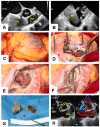Resection of a Solitary Right Ventricular Metastasis in Oligorecurrent Hepatocellular Carcinoma
- PMID: 38137599
- PMCID: PMC10743666
- DOI: 10.3390/jcm12247530
Resection of a Solitary Right Ventricular Metastasis in Oligorecurrent Hepatocellular Carcinoma
Abstract
Hepatocellular carcinoma (HCC), constituting the predominant manifestation of liver cancer, stands as a formidable medical challenge. The prognosis subsequent to surgical intervention, particularly for individuals presenting with a solitary tumor, relies heavily on the degree of invasiveness. The decision-making process surrounding therapeutic modalities in such cases assumes paramount importance. This case report illuminates a rather unusual clinical scenario. Here, we encounter a patient who, following a disease-free interval, manifested an atypical presentation of HCC, specifically, a solitary cardiac metastasis. The temporal interval of remission adds an additional layer of complexity to the case. Through a multidisciplinary planning process, the decision was made for surgical removal of the metastatic tumor.
Keywords: cancer; cardiac surgery; hepatocellular cancer; metastasis.
Conflict of interest statement
The authors declare no conflict of interest.
Figures





References
Publication types
LinkOut - more resources
Full Text Sources

